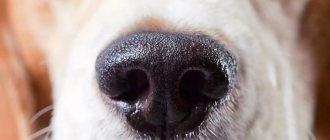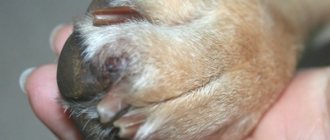Vaseline oil for animals is first aid for constipation. It gently envelops feces, softening them. However, it is not absorbed by the intestinal walls, because it is not absorbed by the dog’s body. There is also a slight stimulating effect on the dog's intestinal motility. Evacuation occurs easily and painlessly, even if the dog has not been able to defecate for several days.
Vaseline forms the basis of various ointments, so it can be used externally to treat skin diseases, to soften crusts on wounds and lubricate irritated areas of the body. The oil is used to soften and accelerate skin regeneration, and with the addition of other medicinal components - for the treatment and prevention of certain diseases.
Content
1. General description 2. Composition and action 3. Purpose 4. Application 5. Contraindications and side effects 6. Price and analogues 7. Reviews
A dog in the house, and especially small puppies, can face various dangers, and one of them is the ingestion of foreign bodies. Even a small object with hard walls or sharp edges can damage the walls of the larynx, esophagus, and stomach. Swallowing function is impaired, internal bleeding is possible, which poses a threat to the pet’s life. Vaseline oil for dogs is widely used for the gentle and safe removal of a foreign object from the animal’s body.
What objects do dogs swallow?
Walking time is one of the most unsafe periods. The dog, when left in its own care, will begin to pick up various objects from the ground. At home, you can hide things that your pet likes to chew. But doing this on the street is problematic.
The list of objects swallowed by dogs is as follows:
- socks;
- rubber balls;
- cellophane and plastic bags;
- large twigs from branches;
- sticks;
- stones;
- toy and real bones;
- Christmas tree tinsel;
- coins;
- elastic bands and hair clips;
- threads, etc.
On a note!
You need to carefully monitor the items used to prepare meat dishes. They have the taste and smell of meat, so they will be attractive to pets.
Composition and action
As an active ingredient, medical vaseline oil contains liquid paraffin. This product is a purified fraction of petroleum. Vaseline oil does not contain harmful organic substances and their compounds, so it can be used as a medicine.
The drug is used orally. The main indication for taking petroleum jelly in both medicine and veterinary medicine is constipation, hardness of stool, which causes discomfort and leads to the threat of damage to the intestinal walls. The drug is safe, but has contraindications and can cause side effects if taken for a long time.
How to give correctly?
To properly give a dog Vaseline oil, you need to open its mouth and pour the drug with a spoon closer to the root of the tongue . If the pet resists and it is not possible to give the medicine this way, then you can use another one.
If the animal resists
To do this, you need to take a small syringe without a needle. Raise the dog's head a little and pull back the lip in the corner of the mouth. Then inject the medicine using a syringe , inserting its tip into the space between the upper and lower teeth. After this, you need to stroke the dog’s neck in the direction from the throat to the esophagus. This will help the animal swallow the oil better and faster.
Healthy! It is most convenient to give the dog medicine together: one person holds the animal and opens its mouth, and the second person pours in the oil.
Purpose
For veterinary purposes, specialists use petroleum jelly when small foreign objects are detected in the digestive tract if:
- there is no need for emergency surgery;
- there is no threat to the pet’s life;
- no signs of internal bleeding were found;
- there is a high probability that the foreign body can leave the body on its own in the feces.
In this case, Vaseline oil is used to speed up the process of removing the foreign body from the body through the intestines.
If the dog swallows an inedible object
With the arrival of a puppy in the house, the owners have more troubles. It is important not only to provide your pet with a healthy and nutritious diet, organize a place and train, but also to ensure the safety of the animal. You will have to be especially careful when cleaning the house, not leaving any of the following on the floor or furniture:
- small, hard and sharp objects;
- handicraft supplies (needles, scissors, etc.);
- candy wrappers, foil wrappers, etc.
The dog’s diet should not contain tubular and sharp bones, river fish, which contain a lot of small bones, seeds, nuts, crackers and similar foods that can damage the pet’s esophagus, stomach and intestines. You should also make sure that someone else does not treat your dog with such “treats”, so that the dog does not pick up anything from the ground while walking on the street.
But it is impossible to foresee everything and monitor the animal 24 hours a day. If it happens that your dog has swallowed something illegal and dangerous, you should take action as soon as possible, especially if there are symptoms indicating that a foreign object is stuck in the mouth or esophagus. This can be determined by characteristic features.
If a foreign body is stuck in the mouth, the dog may:
- excessive salivation;
- swallowing dysfunction;
- urge to vomit.
The dog loses interest in food, shakes its head, shakes it, rubs its cheek against furniture and other objects and tries to get the stuck object out of its mouth with its paws.
If a foreign body is stuck in the larynx, the dog loses appetite, the temperature rises, breathing problems appear, and signs of suffocation are possible. Upon examination, the veterinarian may notice swelling of the larynx. If your dog swallows a sharp object, you may see blood in your saliva when coughing. The dog should be taken to the vet immediately.
Damage to the esophagus and stomach is especially dangerous. Signs of esophageal injury:
- lack of swallowing reflex;
- vomiting after feeding, sometimes with white foam.
To relieve its condition, the dog often stretches its neck. Trauma to the esophagus is dangerous; it is fraught with rupture, inflammatory processes in the esophagus and necrosis of its tissues.
In most cases, small foreign objects swallowed by a dog pass safely through the esophagus and stomach, but become stuck in the small intestine. The following symptoms may indicate this dangerous condition:
- the dog does not eat at all, but feels constant thirst;
- she suffers from severe vomiting;
- the animal’s condition is serious and deterioration is increasing;
- if the intestinal walls are damaged, bloating will occur;
- There is no intestinal peristalsis, the dog cannot defecate.
Important!
Any suspicion that the dog has swallowed an inedible object is a reason to immediately contact a veterinary clinic.
X-ray examination is used to determine the presence and location of a foreign body in the animal's body. After this, the veterinarian determines whether it is necessary to perform surgery, or whether it is possible to do without surgery, stimulating the natural removal of the foreign body from the animal’s body using laxatives. Among others and more often than others, Vaseline oil is recommended.
The essence of therapy with Vaseline oil is that it envelops a foreign object in the intestines and removes it from the body with feces.
Important!
You should not give Vaseline oil to a dog on your own if you suspect the presence of a foreign body in the intestines. Only a specialist can determine the danger of injury, and in case of intestinal obstruction, any laxatives are prohibited.
You should not give oil if the dog has swallowed a bone or object with hard corners or sharp edges. As it passes through the small intestine, there is a high probability of causing further injury.
Sources of the problem "constipation"
The most common cause of constipation not related to illness is poor nutrition:
- Wrong diet: Lack or low amount of fiber in food;
- Pet's consumption of waste;
- Consumption of dry food when there is insufficient fluid intake in the dog’s body;
- Monotonous food;
- Food based on steep broths;
- Overfeeding;
- Eating bones;
Causes of constipation associated with physiological pathologies:
- Diseases of internal organs - gastrointestinal tract, liver, kidneys;
- Injuries of the pelvic bones;
- Entry and blockage of the intestines by foreign objects;
- Inflammation of the prostate and paraanal glands;
- The presence of parasites - worms in the intestines;
- Intestinal atony;
- Dysbacteriosis of the large intestine;
- Diseases of the anus;
- Neurological pathologies (paresis, paralysis);
- The presence of tumors in the intestines;
- Spinal injuries.
Application
Vaseline oil is used in two cases. If the swallowed object is round in shape and has a smooth surface, the laxative helps increase intestinal motility. The oil envelops the foreign body, forming a smooth film, which helps it move toward exit from the body.
For this purpose, it is recommended to give the dog Vaseline oil on an empty stomach at the rate of 1 teaspoon per 10 kg of animal weight. For small breed dogs, the dose will be 1⁄2 teaspoon. You need to feed your pet oil up to two times a day. The laxative effect will appear after a few hours.
Important!
Treatment should not be continued for more than 5 days.
Vaseline oil is used in another method of removing a foreign body that is located in the esophagus of a pet. The manipulation is carried out in a veterinary clinic using an esophagoscope (probe). With its help, a foreign object stuck in the esophagus is pushed into the stomach, and before that the animal is given 2-3 teaspoons of vaseline oil. This will help lubricate the walls of the esophagus so as not to damage them.
Useful tips
Safe toys sold in pet stores are great for playing with pets. They are designed to be difficult to swallow. Particular attention should be paid to puppies: active babies try everything they can get their jaws on.
Other recommendations will help prevent your dog from swallowing foreign objects:
- remove bones from the menu;
- observe the pet while walking, select objects that it tries to gnaw;
- give your pet dried treats strictly under supervision, after removing small components from them;
- remove scissors, threads, needles and other objects that can cause serious harm from accessible places;
- start training a dog; obedient animals take care of their owner’s property, even with a great desire to chew it off.
The principle of training is simple: you need to train your pet to spit out an object on command. The average duration of such training ranges from several weeks to a couple of months.
Contraindications and side effects
Vaseline oil does not contain components that can cause serious negative consequences for the health of the animal, however, like any other medicine, it has restrictions on its use.
The laxative should not be used:
- in case of individual intolerance, therefore the first time you give oil to a dog, you should be extremely careful;
- inflammatory processes in the abdominal organs;
- pregnancy - the drug stimulates uterine contractions, which can lead to miscarriage or premature birth;
- high body temperature;
- intoxication of the body with phosphorus and its derivatives;
- suspected internal bleeding, requiring immediate contact with a veterinary clinic;
- intestinal obstruction.
An overdose of Vaseline oil is not dangerous for pets, but you should stick to the dose prescribed by your veterinarian. The second limitation is the duration of the course - a laxative should not be given for more than 5 days in a row, as this can lead to disruption of intestinal motility and a decrease in its tone. Long-term use of petroleum jelly reduces the absorption of vitamins A, E, K.
Symptoms of the presence of a foreign body in a dog’s body
The first warning sign is vomiting. They appear 2-3 hours after eating food. Vomit may still contain whole pieces of recently eaten food.
There is a whole list of symptoms indicating the presence of a foreign object in the dog’s gastrointestinal tract:
- poor or absent appetite;
- excruciating thirst;
- difficulties with defecation: the dog bends, there is severe discomfort, the amount of feces decreases, there are blood clots in it;
- lack of physical activity;
- aggressiveness or defensiveness when trying to touch the abdominal cavity;
- abdominal tension.
The animal no longer needs to eat and drink, and internal bleeding is possible, coupled with damage to the gastrointestinal tract. For example, the intestines can be injured by the presence of sharp objects in it.
If the dog looks unhealthy and the list of symptoms matches more than 80%, you should immediately contact a veterinary clinic. Self-medication is extremely dangerous - your pet’s life may be at risk.
When is papaverine used?
constipation: regulation of the physiological rhythm of colon emptying;
softening of stool for medical purposes (hemorrhoids, operations on the colon and anus);
hepatic encephalopathy - treatment and prevention of hepatic coma and precoma;
intestinal dysbiosis; enteritis caused by salmonella, shigella, salmonellosis in the stage of bacterial carriage; putrefactive dyspepsia syndrome (in young children as a result of acute food poisoning).
Indications for laxatives
- The interval between bowel movements doubled without changing the diet;
- The dog in front of you swallowed a small, not sharp, but inedible object;
- Gluttony.
Contraindications to the use of laxatives are undiagnosed rectal bleeding, concomitant vomiting, intussusception, intestinal obstruction, perforation of its walls.
Without the prescription of a veterinarian, it cannot be used for palliative care, liver and kidney disease, gastrointestinal neoplasms, pregnancy, diabetes, situations where the dog, for one reason or another, cannot assume a position for defecation.
General forecast
In more than 85% of cases the prognosis is favorable. It will be possible to remove the foreign object and restore the pet’s general well-being without consequences, if the presence of the foreign body does not lead to complete obstruction.
However, the specific forecast depends on the following factors:
- location of the foreign body after ingestion by the dog (in the stomach, esophagus, respiratory tract, etc.),
- size and shape of the object (blunt or with sharp edges, small or large, made of metal, plastic, etc.),
- general condition and age of the pet,
- the presence of complications that are already caused by ingestion of a foreign body.
Remember that the sooner you seek veterinary help, the higher your pet's chances of a full recovery. If you delay a visit to the doctor, complications may develop (intestinal damage, internal bleeding, peritonitis, soft tissue necrosis, etc.).
Administration of an enema
An enema is considered the best way to combat constipation. In this case, the oil acts in the same way as when taken orally, but does not contribute to the removal of vitamins from the body.
It is not used in its pure form, but mixed with warm boiled water. The result is a stable homogeneous emulsion.
The dosage is calculated taking into account the following points:
- For 100 ml of liquid take 20 ml of oil;
- Small dogs require half the amount of the drug for the same volume of liquid.
Before administration, the solution is heated to +38⁰C. Shake the container, then perform the following steps:
- the floor is covered with a diaper and oilcloth;
- the dog is laid on its side;
- a solution is filled into the bulb;
- the tip is lubricated;
- inject the solution into the rectum;
- the dog's tail is pressed against the anus;
- massage the peritoneal area with your hand, performing light pressing movements in a clockwise direction.
After just a few minutes, the dog will be able to empty its bowels on its own.
Ear cleaning
You can't pick off the crusts in your dog's ears. The pet may be injured. Therefore, the formations are softened with oil.
The product is applied to the skin. After this, cover the ear with your hand. Massage thoroughly. Thirty minutes later they begin cleaning.
Softened crusts are removed with cotton swabs. Remains of the product are removed with a napkin.
What to replace it with?
How to replace Vaseline oil if you don’t have it on hand? Most often, it is recommended to use sunflower, flaxseed, olive or sea buckthorn oil instead. But since vegetable oils have a thinner consistency than Vaseline , the replacement cannot be complete. They do not coat the intestinal contents as well.
Reference! You can replace Vaseline oil with a pharmaceutical preparation such as Bimin, but it costs several times more. Therefore, so as not to have to look for a replacement, it is better to buy in reserve.











